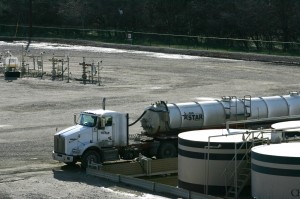Rogers, the former investment banker, is currently a member of the Board of Earthworks/Oil and Gas Accountability Project. She started a goat farm in 2003 near Ridgmar Mall and became an activist on gas issues in 2009, when some of her goats died after being exposed to hazardous fumes from a nearby drilling operation.

“The way it worked is this,” she said. “In the beginning, the industry believed their own public relations. They really did think their wells would produce for decades. Chesapeake’s CEO McClendon estimated that the reserves of shale oil and gas were larger than ‘two Saudi Arabias’ at one point.”
Unfortunately, the wells didn’t perform as expected, “and the gas companies quickly learned that refracking the wells didn’t work and was just a very expensive exercise,” she said.
But the companies doing the drilling had committed millions of dollars to leasing acreage in the various shale plays and could not simply abandon that investment by letting those leases expire. Nor could they hold back on drilling even when the price of gas began to fall, Rogers said, because of the debts they carried.
“They had to keep drilling even though it didn’t appear to make economic sense, because they didn’t have any cash on their balance sheets, and they had tons of debt from all that leasing and the early drilling they’d done,” she said. “So continuing to drill — despite a growing glut that was dropping the bottom out of gas prices — was the only way they could make their debt service. That’s what we call the ‘drilling treadmill.’ They can’t get off.”
With prices so low, wouldn’t it make sense for companies to drill to maintain leases but not put their product on the market until prices rose? “They might want to wait,” Hughes said, “but they can’t hold back because of their debt structure. Wall Street investors are not known for taking a long look at things, even if the long look would show them what’s in their best interests. If they see production falling, the stock price will get hit.”
While the gas companies were scrambling to service their debt and keep their companies afloat, their investors and their investment bankers came up with an idea to make a fortune for themselves. The declining gas prices “opened the door for significant … deals worth billions of dollars … for the investment banks,” Rogers wrote. Wall Street began making deals to “spin assets of troubled shale companies off to larger players in the industry.”
Those included bundling of leased properties and selling off non-productive areas in shale plays. “Leases were bundled and flipped on unproved shale fields the same way as mortgage-backed securities had been sold on questionable … mortgage assets,” Rogers said.
“Investment banks used to help their clients,” she said. “That changed in the mid-1980s. They became predatory. They make money on the way up or the way down, it doesn’t make any difference to them.”

The banks made money on the loans they made to the gas companies, she said, and then when the fields didn’t produce as originally thought, the banks “realized that these companies were highly leveraged, and they kept the pressure on them through production targets. The rest is simple math: You could extrapolate that you would have a significant glut and that the prices would drop.”
Then the bankers turned to the major energy companies, both domestic and foreign, companies that Rogers said wanted nothing to do with shale at that point, and told them they could “pick up these assets for pennies on a dollar.”
So began a feeding frenzy of mergers, lease acquisitions, the outright sale of assets, and — in the case of XTO Energy — the acquisition of the entire company by ExxonMobil. The frenzy accounted for more than $46 billion in deals in 2011 alone, becoming the “largest profit centers for some Wall Street investment banks,” Rogers said.
The problem was that within 12 to 18 months, “the majority of these deals went south on the new owners,” Rogers said. “They’ve had billions of dollars of write-offs, and that translates into shareholder destruction. You’ve bought assets, but they’re no good anymore. And these numbers are huge, and they’re still growing.”
She pointed to two recent examples: Quicksilver Resources has had $2 billion of asset write-downs — writing down the value of assets — in the last six months. And Chesapeake sold its Fayetteville shale assets to the Australian mining giant BHP Billiton LTD.
At the time of that sale, Billiton boasted that it had more than doubled its U.S. oil and gas reserves, claiming it had added 10 trillion cubic feet of gas through the acquisition. Billiton paid Chesapeake $4.75 billion in cash in the February 2011 deal, but a year and a half later, they had to write down more than half of that investment. “The reserves are just not there,” Rogers said.
The losses hit everyone: Devon took $2 billion in losses in 2012; Chesapeake lost $3 billion in write-offs last year. “And the problem is that those write-downs, those losses, have an impact in the real world,” Rogers said. “The New York state pension fund was one of the largest owners of Chesapeake stock, and they have gotten creamed. This is reaching down into people’s retirement plans.”
Long before the massive merger and acquisition frenzy and the huge write-offs and write-downs began, some gas companies began to look at tight oil, or shale oil, for financial relief. Those are shale gas plays where there is a high volume of good quality oil that comes up with the natural gas. Two shale gas fields, the Bakken in North Dakota and Montana, and the Eagle Ford in Southeast Texas, produce about 80 percent of all the tight oil in the United States.
The method of extracting the oil with the gas is the same horizontal fracking used in natural gas drilling, but producers claim that because they’re really after the oil, the gas they get is free. But not everyone agrees with that assessment.
Sharon Wilson, Texas’ Oil & Gas Accountability Project representative and long-time activist against urban drilling, recently returned from a trip to the Eagle Ford play. “The drillers are not even looking at the gas as worth the price of putting in the infrastructure to capture and move it anymore” she said. “They’re capturing the oil that’s in the wet gas field and just letting the poisonous gas out into the atmosphere. When you look at the wells, the compressor stations, the processing facilities with an infrared FLIR camera that allows you to see gas in the air — well, it’s simply exploding out into the air.”
In the Bakken field, once considered the new Barnett Shale, Rogers said no one has even been willing to invest in a pipeline to move the oil and gas because “they see the handwriting on the wall. The reserves are declining too fast to warrant the $1.8 billion it would take to put a pipeline in place. So they’re shipping their product overland by train at triple the price. That tells you a lot about how fast those fields are declining.”
Mark Haggerty, an economist with Headwaters Economics, a nonpartisan, nonprofit economic research group, studied the Bakken. “About one-third of all the gas there is just being flared off,” he said. “It’s just not what they’re after.”
Between the Eagle Ford and the Bakken, it’s estimated that five billion barrels of good oil will be produced before the wells either go dry or are no longer economically feasible. According to Hughes, that’s about a 10-month supply of oil for the United States — not exactly a game changer.
At first, Haggerty said, gas companies estimated that once the field was drilled out, “it would produce 3.5 million barrels of oil a day. The reality is that it will probably only reach one million barrels daily in the next two years, and then it will start dropping off.”
For Haggerty, the dropoff will not only affect the bottom lines of the companies invested in tight oil and shale gas but also the communities from which those resources are extracted.
“We’ve done a lot of work looking at tax revenues versus the costs to the community,” he said. “And the real issue is: How does a community cope with what happens after the boom goes bust? You want the drilling for the tax revenue and royalties and jobs it creates. But at some point the impacts generated by the industry — the industrial and social impacts — simply outstrip the benefits of drilling. And for some communities, in the long run, they can wind up worse than they might have been if there had been no drilling at all.”
********
There is one way for the gas companies to get off their drilling treadmill. That would be exportation. In Japan, China, and Korea, a thousand cubic feet of natural gas goes for about $18 to $20 compared to just over $3.30 here in the United States. If companies like Chesapeake and Devon could liquefy their gas and ship it overseas, even at an estimated production and shipping cost of $9 per thousand cubic feet, they could do well, even with declining fields.
There are problems with liquefied natural gas (LGN) exportation, however. The United States currently has eight locations set up for receiving LNG from the Middle East but none set up for exporting it. Building the necessary terminals to convert natural gas to LNG would cost billions of dollars. And big industry, from companies like Monsanto to electricity providers that rely on natural gas to power their plants, are fighting tooth and nail against the export of natural gas, which would immediately eliminate the glut and steeply increase the cost of natural gas domestically.
(One of the reasons that TransCanada is so intent on bringing its tar sands down through the United States to the international free-trade port at Port Arthur is that the tar sands can be relatively inexpensively refined in Houston with cheap natural gas. If the price of natural gas goes up, a lot of expected tar sands profit goes out the window.)
Nonetheless, in October 2011, according to Rogers, the Department of Energy granted the first shale gas export permit, to Cheniere Energy, a Houston-based energy company that owns the LNG terminal in Sabine, La. By November 2012, Rogers said, the number of LNG export permits had reached 18 and represented a commitment of “60 percent of current U.S. consumption.” Such exports are expected to begin by late 2014 or early 2015.
If natural gas exports gear up, there would be a fairly quick and hard impact on consumers of natural gas in the United States. That is not a problem for the gas companies.
“Oil and gas companies are in business to extract hydrocarbons as cheaply and efficiently as possible and get them to the customer who will pay the highest price,” Rogers wrote. “Platform rhetoric about energy independence is nonsense.”
Hughes sees that happening in the next three to five years. “Once the glut is used and the primary fields have aged and lost productivity, there will be a shortage,” he said. “And at that point the price of natural gas will skyrocket. And the consumer will be the one paying for that as companies pass along the increased cost.”
Of course if the price of natural gas skyrockets, even peripheral shale gas fields and older fields — particularly those where the infrastructure is already in place, like the Haynesville, the Marcellus, and the Barnett — will be worth drilling again.
“What we’re looking at is a classic consumer squeeze,” Rogers said. “And if it’s not pretty now, just wait a few years.”












So when they come back, we need to be ready with lock tight Gas Drilling Ordinances that are as protective to the public health as possible. Arlington has too many loopholes in their ordinance…I live, breathe, and blog in BarnettShaleHell.
Why do they keep poking holes to get hydrocarbons out of the ground then purposely vent massive amounts of those hydrocarbons into the air? see video at here http://www.texassharon.com/2013/03/09/emissions-video-marathon-sugarhorn-central-facility-in-eagle-ford-shale/
The latest research shows that viewed on a 20-year timeframe, methane is 105 X more potent as a GHG than CO2! When viewed on a 100-year timeframe, methane is 2 to 30 times more potent.
Bad reporting and not based on facts. It is well known that these wells will have to be fraced every seven years. Of course all the companies that have leased and drilled here are just doing it for the hell of it, to squander stockholder and operating cash. Hughes was debunked a long time ago, and Sharon is still trying to stay relevant after she got caught with her hands in the cookie jar with Al Armendariz, Mr. “let’s make an example out of them like the Romans did to the Christians”. Of course Sharon and Al never mention how they are going to power this brave new world, I suppose with wind driven sail vehicles and biofuels which are a farce and take food off the table for the world. But it did not stop Sharon from leasing her Wise County minerals. But she has to make a living working for Earthworks, so have at it.
Johnny Ringo: Calling something bad reporting without backing it up doesn’t amount to anything. Can you explain why Hughes’ stats do not hold up and can you explain where Ms. Sharon Wilson and Mr Armandarez got caught with their hands in the cookie jar? And where does Mr. Rogers report fit into this, as you fail to mention it. I think you need to do that , and do it with real facts, before you can make those accusations. And, as I’m sure you know, when people were asked to lease their lands, they were told the story of energy independence for the USA and mailbox money and how it would help us all. A lot of us fell sucker to that, and a lot of us learned the hard way that if 73 percent of the people in a lot signed on, then we were included whether we signed on or not–in which case it didn’t make sense to ignore the upfront payment, regardless of political bent, unless we were already wealthy. So far, your argument doesn’t hold water because there is no substance.
I look forward to what you will produce.
so what the heck, 10 yrs life isnt so bad afterall.
(assuming the anti’s are correct).;
Pete – you don’t keep up with current events do you like your story is rehashed info from 4 years ago and Armendariz was forced to resign from after all his Fubars. And Wilson of course did lease her minerals for gas exploration which do you not find hypocritical? I suppose like with most ultra anti energy types it is do as I say not as I do. I’ll give you plenty of facts when I get to a computer. You might try researching some real trade journals like Oil and Gas Journal, World Oil, or Oil and Gas Investor. You might even want to read a book by a real energy expert called The Quest. Trying to get your facts from Earthworks or Mother Jones is not journalism. I know hanging out at the Flying Saucer and trashing oil and gas is in vogue but expand a little my friend.
Sharon Wilson leased here minerals LONG before what we know today about the ill effects of drilling were known and she did so because she had no choice. Her neighbors had already leased their minerals and hers were going to be taken with or without her consent. Not signing would mean she lost the minerals without remuneration. Signing the lease at least allowed her to get something for what was being taken from her.
It is nice of you to omit the facts when you attempt to smear somebody. You are truly a fool!
Pete start first with a 2-28-2013 report by UT Austin if you Google “New Assessment of Barnett Shale”. They will also be analyzing three other shale plays in future.
Johnny Ringo, the UT study to which you refer was proven to be a fraud when it was discovered that its lead author, Dr. Charles Groat, was in the employment of an oil and gas company and had a vested financial interest in producing a report favorable to industry. The UT Board of Regents dismissed that report in the name of the University of Texas, and you can confirm that fact by contact them and asking.
All you are doing is regurgitating oil and gas industry lies and propaganda leading to me conclude that you are either employed in the industry, or else just blinding drinking their Kool-Aid without making any effort to independently verify what you say before you say it.
Peter Gorman did an excellent job, using credible sources, to describe the facts. That you do not like the facts does not make them untrue.
Article – read “Musings: Will Barnett shale study end debate over gas outlook?” dated 3-5-2013 in Rigzone based on UT Study not known as a bastion of conservative thought – by G Allen Brooks –
So, the banks get their money coming and going. They’re covered. The gas companies got a boat load of money the first few years. And now that they have made a disgusting mess, they’re going to skip town to skim off the easy pickins’ somewhere else. All the while, they are lining things up to sell our gas to forgein countries for a tremendous profit forcing the price to increase drastically for US consumers. They’re covered. The mouth pieces for the gas companies are paid nicely to defend to industry. They’re covered. Even is Sharon Wilson was misled into recieving a check for signing a lease, I’m sure the amount didn’t cover one of the trips she has made in her efforts to expose the mistruths that are told on a daily basis. The residents that live on the shale are the ones that will be left with the aftermath of the fracking process. We will have to pay astronomical natural gas prices. We will have to breath the air that is being altered. Our water prices will undoubtedly increase. We have to live on top of countless miles of unmarked, unodorized, corrosive pipelines the will surely leak over time. We will have to pay medical bills that far surpass any amount paid for a mineral lease due to the unsafe mfg. process. And what is the price for “quality of life”? Our community and our children will suffer the consequences of pad sites, compressor stations and waste water desposal sites that are crammed up against our homes, schools, churches, lakes and parks for unforseeable years. We had only a few natural areas set aside, mainly with our tax dollars, to conserve history, wildlife and original ecosystems. Now so many of those have been depleted or destroyed. When the gas and oil companies are finished raping our once beautiful and proud land, they will sell out, change names and move on to do it again where profits come a little easier. If it weren’t for writers who aren’t afraid to speak up or activist who can’t be intimidated, it would be like getting assaulted with tape over our mouths.
Also don’t forget the Obama administration and their big push to shut down coal powered power plants and make the switch to natural gas powered power plants. That’s going to cost us big time in a decade or so as well. Thanks for nothing Pres. Zero….again.